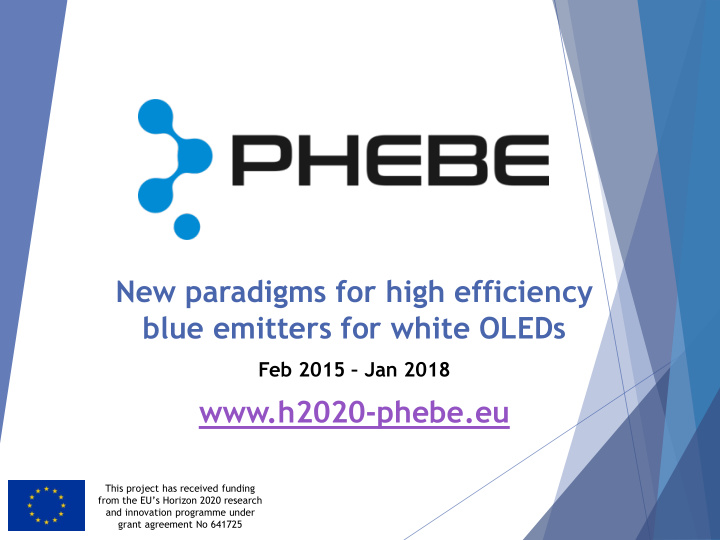



New paradigms for high efficiency blue emitters for white OLEDs Feb 2015 – Jan 2018 www.h2020-phebe.eu This project has received funding from the EU’s Horizon 2020 research and innovation programme under grant agreement No 641725
Rationale Two key issues prevent current iridium-based, phosphorescent OLED emitters from gaining a major fraction of the world lighting markets: Iridium is the fourth rarest naturally-occurring element on the planet, so basing a large-scale, high-volume lighting industry on this resource is risky as well as detrimental to the environment. Iridium-based blue phosphor devices have short working lifetimes and low energy efficacy that are well-below industry expectations. Recent research by Durham University on intramolecular charge transfer systems that enable TADF (ICT-TADF) and intermolecular exciplex charge transfer systems that enable TADF (Exciplex-TADF) has demonstrated very promising improvements in energy efficacy. Moreover, the novel molecular systems do not use iridium.
Overall Objective Create innovative, high-efficiency, blue emitters for white OLEDs, which will create a major breakthrough in the cost performance and environmental-friendliness of OLED lighting. Develop thermally activated delayed fluorescence materials without iridium Design new high-efficiency blue emitters Produce novel white OLED lighting systems
Scientific and Technical Objectives • Screen potential ICT-TADF and Exciplex-TADF Objective 1 compounds with theoretical models • Synthesise the most promising ICT-TADF and Objective 2 Exciplex-TADF model compounds • Characterise and select the best ICT-TADF Objective 3 and Exciplex-TADF synthesised compounds • Design white stack units employing selected Objective 4 TADF based emitter and block materials • Design close-to-production OLED lighting Objective 5 panel demonstrators
Work Plan Material Modelling, Synthesis and OLED Component OLED Lighting Device Characterisation Phase Production Phase Production Phase Modelling OLED Lighting Emitter Layer (TU Dresden) Panel Design and Demonstrators White Stack Integration (Astron-FIAMM) Synthesis (Novaled) (KTU) Characterisation (Durham University) Dissemination and Exploitation (Intelligentsia) Project Management (Intelligentsia) Main task flows WP Interdependencies
Expected Impacts Cost performance breakthroughs - lighting systems with production costs of 1 € /100 lm Secured and reinforced industrial technology leadership and substantially increased market presence in lighting Improved business opportunities and value creation in Europe in lighting by reinforced cooperation along the value chain
Consortium
Contact information Project Coordinator: Giles Brandon Intelligentsia Consultants (Luxembourg) Tel.: +352-263-94-233 Email: giles.brandon (at) intelligentsia-consultants.com www.intelligentsia-consultants.com Subscribe to the PHEBE newsletter via the project website: www.h2020-phebe.eu
New paradigms for high efficiency blue emitters for white OLEDs Feb 2015 – Jan 2018 www.h2020-phebe.eu This project has received funding from the EU’s Horizon 2020 research and innovation programme under grant agreement No 641725
Recommend
More recommend